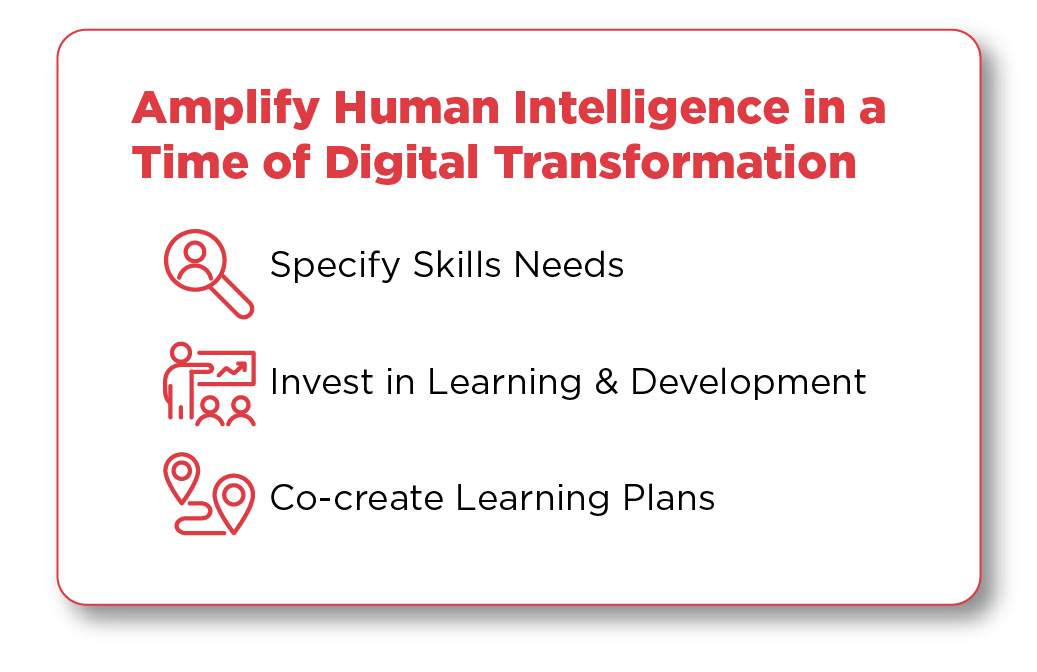Organizations have been increasing their investments in artificial intelligence (AI), and the results so far have been mixed. Gartner [1] found that four of five AI projects don’t meet their intended objectives, and the Harvard Business Review estimated that 90% of enterprises struggle to scale them from the pilot phase to production.
 I don’t expect these challenges to stop companies from continuing to harness new technologies; however, I hope the statistics remind leaders to pause and evaluate the way they approach digital transformation.
I don’t expect these challenges to stop companies from continuing to harness new technologies; however, I hope the statistics remind leaders to pause and evaluate the way they approach digital transformation.
Many executives are so focused on the AI tools themselves that they forget about one essential element of their successful integration: people. Leaders who embrace trust-centered AI adoption and prioritize augmenting rather than automating their employees’ work will support growth and innovation for their personnel and their businesses.
Common Staff Concerns About AI
Executives can start by acknowledging the elephants in the room. Two-thirds of employees [2] are worried that AI systems will replace them, and 25% say that part of their job has already been replaced.
Many people are worried that the skills they’ve taken years to build will become obsolete, which could affect their livelihoods. I’m also seeing apprehension about bias from AI outputs, which is certainly a risk if they are left unvetted, as well as fear that human creativity and people themselves may become devalued in pursuit of constant efficiency.
These concerns are all understandable and often lead to challenges when it comes to technology acceptance. By adopting a human-centric approach to AI integration, you have a chance to change the narrative and engage your employees in this latest digital evolution.
Embracing AI Augmentation in the Workplace
To bring people to the forefront, leaders can consider their intentions with AI automation versus AI augmentation. In automation, businesses typically replace staff with machines that can do similar work. Augmentation focuses on enhancing employee abilities with new technologies.
 Organizations will likely invest in both solutions. AI automation can take on mundane tasks to free personnel up for other, more complex work. For example, think of a marketing team that uses generative AI to analyze trends and market dynamics quickly while leaning on their content professionals to engage in strategic thinking and make smart decisions about how to use that data for an upcoming campaign.
Organizations will likely invest in both solutions. AI automation can take on mundane tasks to free personnel up for other, more complex work. For example, think of a marketing team that uses generative AI to analyze trends and market dynamics quickly while leaning on their content professionals to engage in strategic thinking and make smart decisions about how to use that data for an upcoming campaign.
Reinforcing your company’s commitment to augment – not just automate – will help employees recognize how their roles might advance and how they can grow. The distinction also demonstrates that your organization is committed to its people, enhancing trust and cultivating a culture where individuals recognize their critical role in a workplace driven by human-AI collaboration.
Why Trust-Centered AI Adoption is Non-Negotiable
Investing in employee confidence has a significant effect on performance. High-trust companies [3] experience 50% greater productivity, 40% less burnout and staff members with 106% more energy. Oak Engage [4] also uncovered that mistrust is one of the top reasons that personnel resist change.
When leaders focus on trust, they will apply a deliberate approach by introducing technological adoption through:
- Clear communication – Regular and consistent messaging is essential.
- Transparency – Honesty reduces the likelihood that inaccurate stories about the implementation will circulate.
- Employee involvement – Being partners in innovation helps staff feel valued and increases their willingness to embrace AI.
Using Emergenetics to Amplify Trust in AI Practices
To communicate effectively, consider how your audience wants to receive the information you’re sharing. The seven Attributes can help you craft a message that speaks to the ways your employees prefer to think and behave.
 Analytical
Analytical
Connect to team members with an Analytical preference by explaining the why behind integrating AI systems. When Analytical Thinkers see strong reasoning and benefits that enhance their own efficiency, they are more likely to engage.
 Structural
Structural
People with a Structural preference generally appreciate guidelines and clear agreements. Communicate how new AI tools will be rolled out, explain the practical improvements individuals will see in their day-to-day and set realistic expectations around usage.
 Social
Social
Demonstrate that you care about personnel by reinforcing that the intention behind AI integration is not to replace people. It’s meant to improve the workplace experience and the business’s effectiveness. Social Thinkers will also appreciate hearing about how the organization plans to support the workforce through upskilling.
 Conceptual
Conceptual
Engage staff with a Conceptual preference by inviting them to test new approaches to work that promote human-AI collaboration. When they have an opportunity to experiment with the technology themselves, they are more likely to adopt it.
 Expressiveness
Expressiveness
Inspire conviction across the Expressiveness spectrum by finding ways to get feedback from all staff, including their concerns as well as their considerations for effectively integrating AI technologies into business processes.
![]()
Assertiveness
Proactively share your AI roadmap so personnel recognize the speed with which the company intends to introduce digital tools. Having an understanding of the anticipated pace will help teammates across the Assertiveness continuum prepare.
 Flexibility
Flexibility
Honor the Flexibility spectrum by explaining which decisions are final and where changes are still expected as teams adopt AI tools and implement new practices.
Human-AI Collaboration — Paint the Picture of The Future of Work
To further build trust, create a vision for the future workplace [5] and share it with employees so they can see their roles in it. What this picture looks like will vary for every organization, and be sure your vision includes:
How You Will Leverage Technology
Illustrate what you expect your AI systems to do for your business. In some cases, they may take on existing functions managed by people, such as repetitive tasks, data analysis or predictive analytics. In other instances, they will open up new fields and expand on what your company can do today. Describe how these AI agents will work as partners to support human decision-making.
How You Will Elevate People Skills
The human capabilities that we bring to work, including our creativity, critical thinking, strategic mindsets and relationship-building competencies, are still essential to organizational success [6]. We can’t rely on generative AI alone to innovate and make decisions. We’ll need to pair that output with our own judgment, emotional intelligence and critical thinking. Illustrate the opportunities that human-AI collaboration will bring to the workforce and the new skills and functions that will become in-demand.
Practical Ways to Amplify Human Intelligence in a Time of Digital Transformation
 With your vision defined, build a plan to help your human workers reach the desired future state. Get started by:
With your vision defined, build a plan to help your human workers reach the desired future state. Get started by:
Specifying Skill Needs
Staff need more than just data literacy competencies and confidence in using AI. It’s also important that they expand their cognitive, interpersonal and self-leadership skills [7]. Build trust by clarifying the specific capabilities that your organization will require in the future and how you expect functions to grow and evolve in the next three, five and ten years.
Invest in Learning & Development
Empower your talent development teams to take action in closing skills gaps. Collaborate with L&D to identify the company’s top priorities and how success will be measured. Investing in training solutions, particularly those that support soft skills [8], and outlining learning opportunities will show your staff that you are committed to their long-term growth.
Co-creating Learning Plans
Encourage managers and direct reports to discuss how individuals would like to adapt their roles to support the business’s vision for human-AI collaboration. They can then analyze existing skills and identify new projects or on-the-job learning to grow in-demand competencies.
Trust-Based Culture Starts at the Top
Human-AI collaboration [5] will lie at the heart of sustainable growth. Your capacity to build trust across your workforce and in your AI systems will be a differentiator in the long-term success of your business. The practices I’ve shared will help you create the foundation for innovation, resilience and a future-ready workforce.
As a few final tips, remember that when leaders model the behaviors they want to see, it often encourages personnel to follow suit. Remember to:
- Show curiosity about AI – Take ownership of the fact that you do not know everything about AI tools and are still willing to learn!
- Address AI fears – Listen to your workforce and thoughtfully respond to their concerns.
- Recognize human contributions – With so much focus on AI, people may feel overlooked, so make sure that their successes are celebrated.
- Reinforce metrics beyond productivity gains – Efficiency is not the only metric of success; employee trust, engagement and confidence all contribute to the bottom line.
- Use tools like Emergenetics – Your staff have a variety of reactions as you integrate AI applications into their workflows. Solutions like Emergenetics [9] can help you anticipate and manage their reactions in a positive way, while also helping personnel advance their people skills.
Curious how Emergenetics can help your organization embrace change and thrive in a time of human-AI collaboration? Explore our website [10] or fill out the form below to speak with our team today!